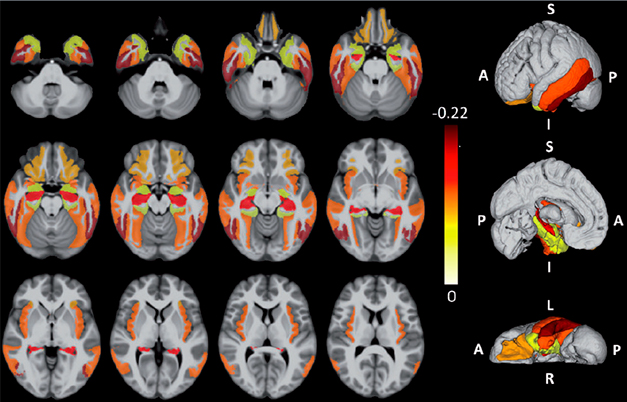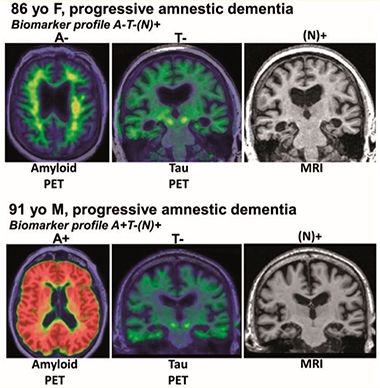Peu de personnes atteignent l’âge de 80 ans sans qu’une sorte de neuropathologie ne se soit développée dans leur cerveau, et la multi-pathologie est la norme. Les neuropathologistes observent couramment des inclusions cytoplasmiques de TDP-43 phosphorylé dans des échantillons de cerveau post-mortem avec ou sans les plaques Aβ et les enchevêtrements neurofibrillaires qui définissent la maladie d'Alzheimer.

Les inclusions contenant cette protéine de liaison à l'ARN ont été impliquées pour la première fois dans la SLA et la FTD il y a plus de dix ans. Peu de temps après, des neuropathologistes ont repéré la pathologie TDP-43 chez des personnes qui avaient des symptômes de maladie d'Alzheimer, et non de FTD (Amador-Ortiz et al., 2007). Elle accompagnait souvent la sclérose de l'hippocampe, un hippocampe rétréci ravagé par la gliose. Plus d'une décennie auparavant, Dickson avait décrit des cas curieux de sclérose de l'hippocampe chez des personnes atteintes de démence sans pathologie de la maladie d'Alzheimer (Dickson et al., 1994).
Les chercheurs soupçonnent maintenant qu'une grande partie de ces cas, ainsi que des cas plus récent, étaient causés par une protéinopathie TDP-43.
Au cours des dix dernières années, plusieurs études ont décrit l’évolution clinique et pathologique de cette protéinopathie TDP-43, récemment baptisée LATE. On peut citer une étude sur TDP-43, dans des échantillons de cerveau post-mortem de près de 1 000 participants décédés, dans le cadre du projet Rush Memory and Aging Project et RUD-MAP (ROS-MAP) (James et al., 2016). La moitié des participants étaient atteints de la pathologie TDP-43 et 37% des participants étaient atteints à la fois de la pathologie TDP-43 et de la maladie d'Alzheimer. Les personnes ayant les deux pathologies étaient plus susceptibles d'être atteinte de démence clinique que celles qui étaient atteinte d'une seule pathologie. Cette étude proposait un schéma de stadification pathologique, dans lequel la pathologie TDP-43 atteignait l'amygdale au stade 1, puis l'hippocampe et le cortex entorhinal au stade 2, et enfin le néocortex au stade 3. Une fois que la pathologie s'étend au-delà de l'amygdale, elle se corrèle bien avec une déficience cognitive.
LATE est une proposition d'une nouvelle maladie neurodégénérative courante, qui a été baptisée ainsi par un groupe international de pathologistes, cliniciens et épidémiologistes dans un rapport de consensus publié le 30 avril dans Brain.
Ce groupe international prédit que cette maladie concerne un diagnostic clinique de maladie d'Alzheimer sur cinq. Dans leur article, rédigé à la suite d’un atelier tenu à Atlanta à l’automne dernier, les chercheurs de Peter Nelson, de l’Université du Kentucky à Lexington, ont résumé les décennies de recherche qui ont précédé l’appellation du terme. Ils décrivent les caractéristiques de LATE, proposent des moyens de la classer et de la diagnostiquer, et appellent au développement de biomarqueurs et de thérapies spécifiques.
Un cas typique d’encéphalopathie TDP-43 liée à l’âge prédominant dans le limbique (LATE), serait celui d'une femme de 86 ans qui développerait les symptômes amnésiques classiques de la maladie d’Alzheimer au cours de ses dernières années de vie, mais à l’autopsie, son cerveau ne porterait plus qu’un fardeau modeste de plaques Aβ et de tau enchevêtrement. Au lieu de cela, les inclusions de TDP-43 auraient envahi ses régions limbiques.
La pathologie LATE coïncide souvent avec la sclérose de l'hippocampe, mais cette dernière n'est pas nécessaire pour un diagnostic.
Quelle est la fréquence de LATE? Les chercheurs de ROSMAP, dirigés par Julie Schneider de Rush, ont analysé à nouveau les données de leur cohorte afin de prendre en compte la mise en scène neuropathologique proposée. Ils estiment l’impact du LATE à environ la moitié de celui de la maladie d'Alzheimer chez les personnes âgées et égal à l’impact combiné de toutes les neuropathologies vasculaires. Cela rendrait LATE environ 100 fois plus répandu que le FTD.

La co-occurrence des neuropathologies maladie d'Alzheimer et LATE chez les personnes âgées complique l'interprétation des essais thérapeutiques spécifiques à la maladie d'Alzheimer et peut même masquer des résultats positifs, a noté Nelson.
On peut se demander quelle est l'utilité de l'introduction d'une nouvelle maladie définie et pouvant être diagnostiquée jusqu'à présent uniquement grâce aux résultats neuropathologiques obtenus post mortem?
Comment les chercheurs vont-ils différencier la nouvelle maladie proposée de la maladie d'Alzheimer? Il n’existe pas de biomarqueurs de fluide ni de traceurs PET pour détecter la pathologie de TDP-43, bien que des chercheurs s’y intéressent. La localisation intracellulaire du TDP-43 et son faible fardeau pathologique compliquent le développement de biomarqueurs. Pour le moment, le mieux que le diagnostiqueur puisse faire est de suivre un processus d'élimination.
Une fois que les biomarqueurs existeront, ils faciliteront les efforts de découverte de médicaments ciblés sur LATE, par exemple sur ses agrégats de TDP-43. Étant donné que les neuropathologies comorbides chez les personnes à risque de LATE pourraient potentiellement interagir (Robinson et al., 2018), Trojanowski a proposé un cocktail immunothérapeutique d'anticorps dirigés contre Aβ, tau, TDP-43 et α-synucléine
 Alzheimer's disease (Alzheimer's disease) is progressive brain disease that affects cognition, memory and behavior.
Alzheimer's disease (Alzheimer's disease) is progressive brain disease that affects cognition, memory and behavior.



